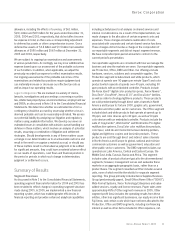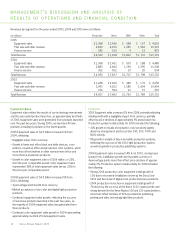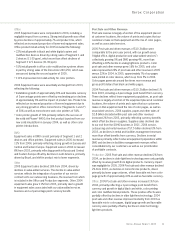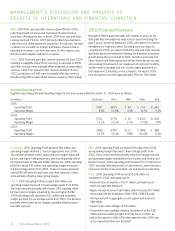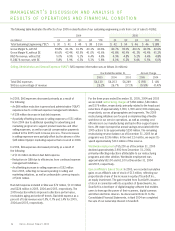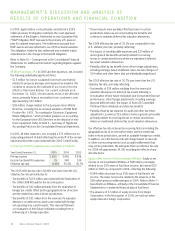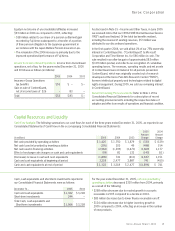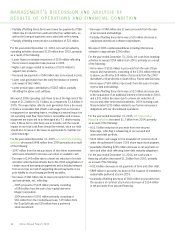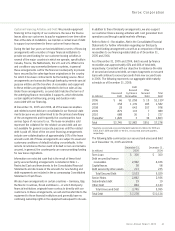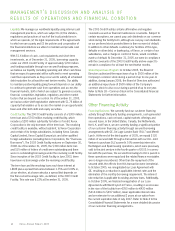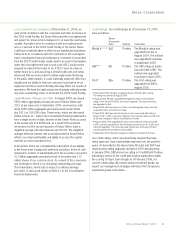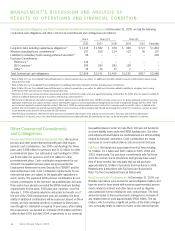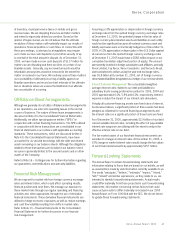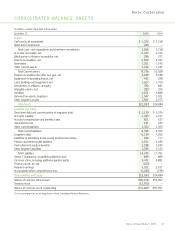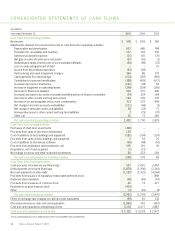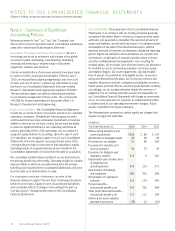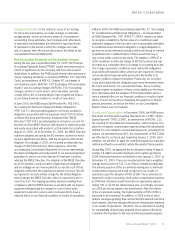Xerox 2005 Annual Report Download - page 49
Download and view the complete annual report
Please find page 49 of the 2005 Xerox annual report below. You can navigate through the pages in the report by either clicking on the pages listed below, or by using the keyword search tool below to find specific information within the annual report.
Xerox Corporation
41
Customer Financing Activities and Debt: We provide equipment
financing to the majority of our customers. Because the finance
leases allow our customers to pay for equipment over time rather
than at the date of installation, we maintain a certain level of debt
to support our investment in these customer finance leases.
During the last four years we had established a series of financing
arrangements with a number of major financial institutions to
provide secured funding for our customer leasing activities in
several of the major countries in which we operate, specifically in
Canada, France, the Netherlands, the U.K. and U.S. While terms
and conditions vary somewhat between countries, in general
these arrangements call for the financial counterparty to provide
loans secured by the sales-type lease originations in the country
for which it has been contracted to be the funding source. Most
arrangements are transacted through bankruptcy remote special
purpose entities and the transfers of receivables and equipment
to these entities aregenerally intended to be true sales at law.
Under these arrangements, secured debt matches the terms of
the underlying finance receivables it supports, which eliminates
certain significant refinancing, pricing and duration risks
associated with our financing.
At December 31, 2005 and 2004, all of the lease receivables
and related secured debt areconsolidated in our financial state-
ments because we are determined to be the primary beneficiary
of the arrangements and frequently the counterparties have
various types of recourse to us. The lease receivables sold
represent the collateral for the related secured debt and are
not available for general corporate purposes until the related
debt is paid off. Most of the secured financing arrangements
include over-collateralization of approximately 10% of the lease
amounts sold. All of these arrangements aresubject to usual and
customary conditions of default including cross-defaults. In the
remote circumstance that an event of default occurs and remains
uncured, in general, the counterparty can cease providing funding
for new lease originations.
Information on restricted cash that is the result of these third-
party secured funding arrangements is included in Note 1 –
Restricted Cash and Investments to the Consolidated Financial
Statements and disclosureof the amounts for new funding and
debt repayments areincluded in the accompanying Consolidated
Statement of Cash Flows.
We also have arrangements in certain countries – Germany, Italy,
the Nordic Countries, Brazil and Mexico – in which third-party
financial institutions originate lease contracts directly with our
customers. In these arrangements, we sell and transfer title to the
equipment to these financial institutions and generally have no
continuing ownership rights in the equipment subsequent to its sale.
In addition to these third-party arrangements, we also support
our customer finance leasing activities with cash generated from
operations and through capital markets offerings.
Refer to Note 4 – Receivables, Net in the Consolidated Financial
Statements for further information regarding our third-party
secured funding arrangements as well as a comparison of finance
receivables to our financing-related debt as of December 31,
2005 and 2004.
As of December 31, 2005 and 2004, debt secured by finance
receivables was approximately 41% and 44% of total debt,
respectively. Consistent with our objective to rebalance the ratio
of secured and unsecured debt, we expect payments on secured
loans will continue to exceed proceeds from new secured loans
in 2006. The following represents our aggregate debt maturity
schedule as of December 31, 2005:
Debt
Secured Other
Unsecured by Finance Secured Total
(in millions) Debt Receivables Debt Debt
2006 $ 66 $1,058 $ 15 $1,139(1)
2007 258 1,139 185 1,582
2008 28 643 307 978
2009 879 103 7 989
2010 688 36 3 727
Thereafter 1,826 3 34 1,863
Total $3,745 $2,982 $551 $7,278
(1) Quarterly secured and unsecured total debt maturities (in millions) for 2006 are
$353, $307, $256 and $223 for the first, second, third and fourth quarters,
respectively.
The following table summarizes our secured and unsecured debt
as of December 31, 2005 and 2004:
December 31, December 31,
(in millions) 2005 2004
Term Loan $ 300 $ 300
Debt secured by finance
receivables 2,982 4,436
Capital leases 38 58
Debt secured by other assets 213 235
Total Secured Debt 3,533 5,029
Senior Notes 2,862 2,936
Subordinated debt 19 19
Other Debt 864 2,140
Total Unsecured Debt 3,745 5,095
Total Debt $ 7,278 $10,124
Xerox Annual Report 2005


